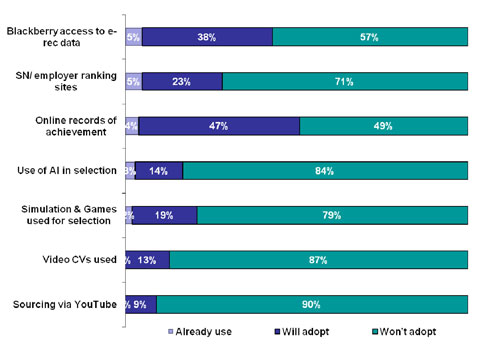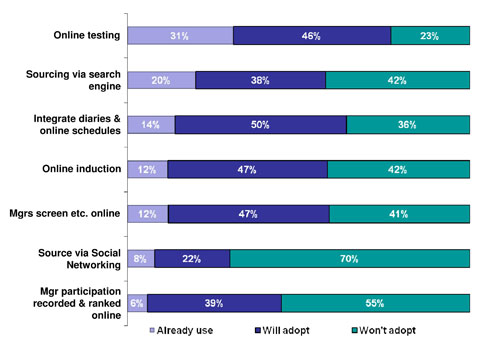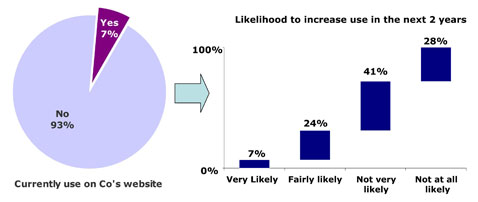

WCN Personnel Today Survey Part 3:
Recruitment to be a very different place in 3 years time - which innovations are recruiters adopting?
Recruitment to be a very different place in 3 years time - which innovations are recruiters adopting?
 Charles Hipps is founder and managing director of award winning e-Recruitment software supplier WCN PLC
(www.wcn.co.uk)
and authored the “Guide to Best Practice e-Recruitment Projects” on behalf of the Government. To find out more about WCN
PLC or discuss this article please visit
www.wcn.co.uk, email
chipps@wcn.co.uk
or call 0208 296 5908.
Charles Hipps is founder and managing director of award winning e-Recruitment software supplier WCN PLC
(www.wcn.co.uk)
and authored the “Guide to Best Practice e-Recruitment Projects” on behalf of the Government. To find out more about WCN
PLC or discuss this article please visit
www.wcn.co.uk, email
chipps@wcn.co.uk
or call 0208 296 5908.
|
The ease of communication and information sharing via the Internet make it much easier to engage and co-ordinate hiring managers, and align recruitment with business needs. By improving the alignment with the business, recruiters have the potential to bring a step change improvement in recruitment. |
|
The results of an exclusive survey by
WCN PLC, leading provider of e-Recruitment and talent management software, in
conjunction with Personnel Today, reveals the experiences
of 400 Personnel Today readers, including HR Directors, Board Level Directors and Managers.
As described in Part 2 of WCN Personnel Today Survey, online recruitment has become the bed-rock of most organisations’ recruitment. Furthermore, the recession appears to be speeding up this move online. e-Recruitment is being adopted because it is cost effective, easy, improves diversity and time-to-hire. Beyond these accepted benefits, what innovations and benefits are recruiters hoping to implement in the next 3 years? |
fig. 2. e-Recruitment Innovations 2 of 2.
|
fig. 1. e-Recruitment Innovations 1 of 2.
|
Finally, half of recruiters (47%) are planning to put their new-employee induction activities online. As our award
winning work, in partnership with Marks and Spencer, has demonstrated,
recruiters stand to cut time and costs, while hires are engaged and productive more quickly.
Surprisingly, given all the publicity and expected benefits, recruiters are relatively wary of adopting new media sources – social networking sites (22%), YouTube (9%), or search engines (38%) – and only 31% expected to adopt Web 2.0 and interactive features (video, podcasts, chat, blogs) on their websites in the next 2 years (fig. 3). Furthermore, only 28% believe another “social” phenomenon – the rating of employers by employees on employer ranking sites - will be a significant factor in the next 3 years. |
|
Online testing and using online records of achievement are two of the innovations being adopted most quickly – 46% and 47%
of organisations expect to adopt them in the next 3 years (fig. 1 & fig. 2).
Transparency, information sharing and the relative ease with which candidates can be tested on-line, provide recruiters with a greater body of information on which to select candidates. All recruitment activities are wasted if the final selection decisions are wrong. By using online tests and records of achievement to improve the quality of hires, recruiters stand to bring significant improvements to recruitment. |
fig. 3. Use of Web 2.0/ Interactive tools
|
| On the other hand, recruiters are either not ready, or don’t believe, that video CVs, artificial intelligence, or multi-period games will improve hire quality – with only 13 %, 14%, and 19% of employers intending to adopt them in the next 3 years respectively. | In summary, organisations are stepping up to the challenges and opportunities of better selection, improved business engagement, and on-boarding candidates more quickly and cheaply. But they appear reticent to address the challenges/opportunities provided by new media sources and technologies to improve the way they attract candidates. Moreover, the nature of the recruiter’s job is changing – increased automation means less administration and the changes outlined above, and many others, provide huge opportunities for competitive advantage, so what skills do recruiters need and what will be expected of recruiters in the future? |
| Organisations are also intending to empower hiring managers by adopting: online candidate screening by managers (47%), integrated diaries and online schedules (50%), access to e-Recruitment via blackberry (38%), and manager participation monitoring (39%). | The survey comprised 403 respondents of whom 4% were board level directors, 8% were directors and 62% were department heads or managers. |